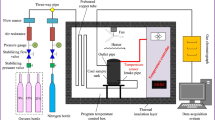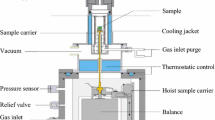Abstract
Prediction of the development and evolution process of coal spontaneous combustion is of great significance to its prevention and control. Through the testing of different metamorphic degrees coal programmed heating characteristics and the infrared functional groups, the critical temperatures of the coalification process were analyzed and a method to predict the period of spontaneous combustion was established according to the characteristic of the critical temperature change. What can be inferred from this research is that the critical temperature of activation energy of coal in programmed heating experiments can characterize the nature of coal at low temperature and the macrocritical temperature point can be obtained from the characteristics of the activation energy change during the low-temperature period. The critical point of coal functional groups in terms of its micro changes is similar to its macro changes, the absorption intensity of the characteristic peak shows a general increasing trend, with an initial decline and then increase, followed by a decrease and a subsequent increase. In the high-temperature combustion process, the activation energy is not constant and changes from a negative value to 0, then the activation energy changes to a positive value, and finally goes down to a negative value. Therefore, the prediction of development period of spontaneous combustion can be achieved through the critical temperature of activation energy which acts as the critical temperature in high-temperature combustion process, and the prediction of low-temperature oxidation process is based on the critical temperature of activation energy in programmed heating process and the macro critical temperature of absorption intensity of coal functional groups.







Similar content being viewed by others
References
Arisoy A, Beamish B (2015) Reaction kinetics of coal oxidation at low temperatures. Fuel 159:412–417
Chen L, Li P, Li G, Cheng W, Liu Z (2018) Development of cement dust sup-pression technology during shotcrete in mine of China-a review. J Loss Prevent Process Ind 55:232–242
Choi H, Jo W, Kim S (2014) Comparison of spontaneous combustion susceptibility of coal dried by different processes from low-rank coal. Korean J Chem Eng 31(12):1–6
Given PH, Marzec A, Barton WA (1986) The concept of a mobile or molecular phase within the macromolecular network of coals: a debate. Fuel 65(2):155–163
Grossman SL, Wegener I, Wanzl W (1994) Molecular hydrogen evolution as a consequence of atmospheric oxidation of coal: 3. Thermo-gravimetric flow reactor studies. Fuel 73(5):762–767
Hu ZX, Hu XM, Cheng WM, Lu W (2018a) Influence of synthetic conditions on the performance of melamine–phenol–formaldehyde resin microcapsules. High Perform Polym 2018:1–14. https://doi.org/10.1177/0954008318758489
Hu ZX, Hu XM, Cheng WM, Zhao YY, Wu MY (2018b) Performance optimiza-tion of one-component polyurethane healing agent for self-healing concrete. Constr Build Mater 179:151–159
Huang B, Zhao X, Quan Z, Mines SO (2016) Framework of the theory and technology for simultaneous mining of coal and its associated resources. J China Univ Min Technol 45(4):653–662
Jassim EI (2015) CFD modeling of toxic element evolved during coal combustion. Arab J Sci Eng 40(12):3665–3674
Jiao XM, Wang DM, Zhong XX, Jin-Shuai LI, Lei D (2012a) Experiment study on different retarder affected to critical temperature of coal spontaneous combustion. Coal Eng 2:11–15
Jiao XM, Wang DM, Zhong XX, Jin-Shuai LI, Lei D (2012b) The analysis of influencing factors on coal spontaneous combustion calculate critical temperature based on CO concentration. Saf Coal Mines 3:11–15
Kong B, Li Z, Yang Y (2017) A review on the mechanism, risk evaluation, and prevention of coal spontaneous combustion in China. Environ Sci Pollut Res 24(1):23453–23470
Kong B, Li Z, Wang E (2018a) An experimental study for characterization the process of coal oxidation and spontaneous combustion by electromagnetic radiation technique. Process Saf Environ Prot 119:285–294
Kong B, Wang E, Li Z (2018b) The effect of high temperature environment on rock properties - an example of electromagnetic radiation characterization. Environ Sci Pollut Res 25(29):29104–29114
Kong B, Wang E, Li Z (2018c) Regularity and coupling correlation between acoustic emission and electromagnetic radiation during rock heating. Geomech Eng 15(5):1125–1133
Krevelen VDW (1993) Coal: typology physics chemistry constitution. Elsevier Science Publishers, Amsterdam
Kuenzer C, Stracher GB (2012) Geomorphology of coal seam fires. Geomorphology 138(1):209–222
Kuenzer C, Zhang J, Sun Y (2012) Coal fires revisited: the Wuda coal field in the aftermath of extensive coal fire research and accelerating extinguishing activities. Int J Coal Geol 102(6):75–86
Li JH, Wang DM, Zhong XX (2012) Critical temperature measuring method of coal spontaneous combustion base on cross-point temperature method. Coal Eng 10:107–109
Li ZH, Kong B, Wei AZ (2016) Free radical reaction characteristics of coal low-temperature oxidation and its inhibition method. Environ Sci Pollut Res 23(23):1–13
Liang YT, Luo HZ (2008) Current situation and development trend for coalmine fire prevention and extinguishing techniques in China. J China Coal Soc 33(2):126–130
Liu Z, Yang H, Wang WY, Cheng WM, Xin L (2018a) Experimental study on the pore structure fractals and seepage characteristics of a coal sample around a borehole in coal seam water infusion. Transp Porous Media 125(2):289–309
Liu Y, Nie W, Jin H, Ma H, Hua Y, Cai P (2018b) Solidifying dust suppressant based on modified chitosan and experimental study on its dust suppression performance. Adsorpt Sci Technol 36(1-2):640–654
Lu SQ, Li L, Cheng YP, Sa ZY, Zhang YL, Yang N (2017) Mechanical failure mechanisms and forms of normal and deformed coal combination containing gas: model development and analysis. Eng Fail Anal 80:241–252
Ni G, Li Z, Xie H, Ni G, Li Z, Xie H (2017) The mechanism and relief method of the coal seam water blocking effect (wbe) based on the surfactants. Powder Technol 323:60–68
Ni GH, Xie HC, Li Z (2018) Improving the permeability of coal seam with pulsating hydraulic fracturing technique: a case study in Changping coal mine, China. Process Saf Environ Prot 117:565–572
Nie W, Wei W, Liu Q, Ma H, Peng H, Liu Y (2018) Simulation experiments on the controllability of dust diffusion by means of multi-radial vortex airflow. Adv Powder Technol 29:835–847
Pone JDN, Hein KAA, Stracher GB, Annegarn HJ, Finkleman RB, Blake DR (2007) The spontaneous combustion of coal and its by-products in the witbank and sasolburg coalfields of South Africa. Int J Coal Geol 72(2):124–140
Sahay N, Varma NK, Ahmad I (2007) Critical temperature - an approach to define proneness of coal towards spontaneous heating. J Mines Met Fuels 55(10):510–516
Song Z, Zhu H, Jia G, He C (2014) Comprehensive evaluation on self ignition risks of coal stockpiles using fuzzy AHP approaches. J Loss Prev Process Ind 32:78–94
Tan B, Qu LN, Wang FR (2013) Experimental study on mechanism of hydroxyl variation and the critical temperatures in the process of coal oxidation at low temperature. Disaster Adv 6:315–321
Tang Y, Xue S (2015) Laboratory study on the spontaneous combustion propensity of lignite undergone heating treatment at low temperature in inert and low-oxygen environments. Energy Fuel 29(8):4683–4689
Wang DM (2012) Mine ventilation and safety. China University of Mining and Technology Press
Wang G, Zhang DS (2018) Innovation practice and development prospect of intelligent fully mechanized technology for coal mining. J China Univ Min Technol 47:459–467
Wang DM, Xin HH, Qi XY (2016a) Reaction pathway of coal oxidation at low temperatures: a model of cyclic chain reactions and kinetic characteristics. Combust Flame 163:447–460
Wang E, Kong B, Liang J, Liu X, Liu Z (2016b) Experimental study on EMR effect of coal heating. J China Univ Min Technol 45(2):205–210
Wang J, Kang H, Liu J, Chen P, Fan Z, Yuan W (2018a) Layout strate-gic research of green coal resource development in China. J China Univ Min Technol 47:15–20
Wang X, Wen Z, Jiang Y, Huang H (2018b) Experimental study on mechanical and acoustic emission characteristics of rock-like material under non-uniformly distributed loads. Rock Mech Rock Eng 51(3):729–745
Wang H, Nie W, Cheng W, Liu Q, Jin H (2018c) Effects of air volume ratio parameters on air curtain dust suppression in a rock tunnel’s fully-mechanized working face. Adv Powder Technol 29(2):230–244
Wen Z, Wang X, Tan Y, Zhang H, Huang W, Li Q (2016) A study of rockburst hazard evaluation method in coal mine. Shock Vib 16:1–9
Wen Z, Wang X, Chen L, Lin G, Zhang H (2017) Size effect on acoustic emission characteristics of coal-rock damage evolution. Adv Mater Sci Eng 2:1–8
Yang SQ, Hu XC, Liu WV, Cai JW, Zhou XH (2018) Spontaneous combustion influenced by surface methane drainage and its prediction by rescaled range analysis. Int J Min Sci Technol 28:215–221
Yong C, Mori S, Pan WP (2002) Estimating the combustibility of various coals by TG-DTA. Energy Fuel 9:71–76
Zhang J, Li Y (2017) Ultrasonic vibrations and coal permeability: laboratory exper- imental investigations and numerical simulations. Int J Min Sci Technol 27(2):221–228
Zhang Q, Hu XM, Wu MY, Zhao YY, Yu C (2018) Effects of different catalysts on the structure and properties of polyurethane/water glass grouting materials. J Appl Polym Sci 46460:1–11. https://doi.org/. https://doi.org/10.1002/app.46460
Zheng L, Deng J (2010) An experimental research on coal spontaneous combustion in different temperature stage. J Armed Police Acad 26(4):16–18
Zhou G, Zhang Q, Bai R, Fan T, Wang G (2017) The diffusion behavior law of respirable dust at fully mechanized caving face in coal mine: cfd numerical simulation and engineering application. Process Saf Environ Prot 106:117–128
Zhou G, Ma YL, Fan T, Wang G (2018) Preparation and characteristics of a multifunctional dust suppressant with agglomeration and wettability performance used in coal mine. Chem Eng Res Des 132:729–742
Zhu HQ, Wang HY, Song ZY (2014) The relationship between oxidation kinetics characteristic parameters of coal adiabatic progress and metamorphic degree. J China Coal Soc 39(3):498–503
Zhu TT, Jing HW, Su HJ (2016) Physical and mechanical properties of sandstone containing a single fissure after exposure to high temperatures. Int J Min Sci Technol 26(2):319–325
Acknowledgments
The authors also thank SISTRANS Editorial Services for editing this paper.
Funding
The research described in this paper was financially supported by the National natural science foundation of China (51804355).
Author information
Authors and Affiliations
Corresponding author
Additional information
Responsible editor: Philippe Garrigues
Rights and permissions
About this article
Cite this article
Qu, L. A study on the prediction method of coal spontaneous combustion development period based on critical temperature. Environ Sci Pollut Res 25, 35748–35760 (2018). https://doi.org/10.1007/s11356-018-3464-2
Received:
Accepted:
Published:
Issue Date:
DOI: https://doi.org/10.1007/s11356-018-3464-2




